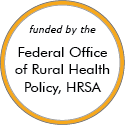Rural Project Examples: Prescription drug misuse
Effective Examples
Vermont Hub-and-Spoke Model of Care for Opioid Use Disorder
Updated/reviewed November 2025
- Need: In the early 2010s, needed increase access to medication treatment for opioid use disorder in rural Vermont.
- Intervention: 2012-2016 implementation of a statewide hub-and-spoke treatment access system.
- Results: The original system's increased treatment capacity and care coordination successes now are a permanent system of integrated care overseen by the Vermont state health department and Vermont Blueprint for Health.
Project Lazarus
Updated/reviewed May 2024
- Need: To reduce overdose-related deaths among prescription opioid users in rural Wilkes County, North Carolina.
- Intervention: Education and tools are provided for prescribers, patients and community members to lessen drug supply and demand, and to reduce harm in prescription opioid use.
- Results: Opioid overdose death rates have decreased in Wilkes County.
Other Project Examples
Arukah Institute's Living Room Program

Added December 2023
- Need: To address high rates of substance use in Princeton, Illinois and the surrounding area.
- Intervention: The Arukah Institute, a local nonprofit organization providing mental health services, adapted a statewide model to provide support and a safe space for people in need of substance use resources.
- Results: The Living Room program had 1,485 visits in its first year, with 100% of clients served by recovery support specialists.
For examples from other sources, see:
